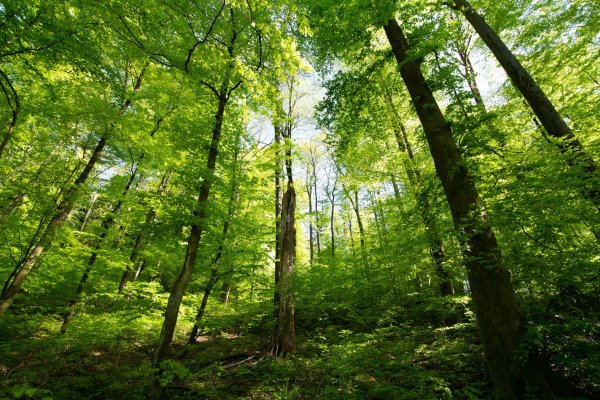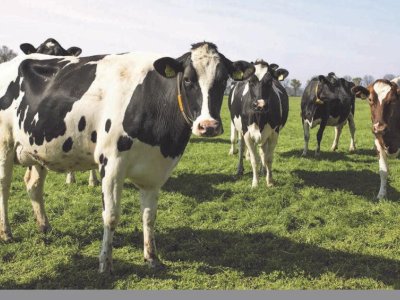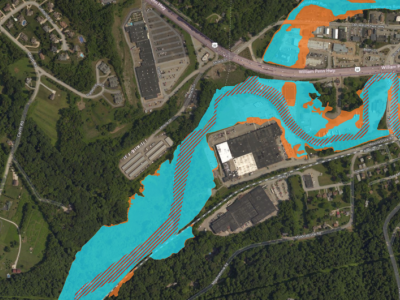The climate crisis has put carbon sequestration and carbon offset projects on the international agenda. But what role can forests play in removing carbon emissions? Numerous studies have proposed sustainable forest management and reforestation as key strategies among nature-based solutions to combat global warming, including the forests of Pennsylvania, whose name translates to “Penn’s Woods.”
The magic happens through photosynthesis: Carbon dioxide is secured in forest biomass. On land, forests, harvested wood products, and urban trees together remain the largest net carbon (C) sink in the United States. In fact, U.S. forests can sequester 584 million metric tons of carbon per year, which offsets about 13% of total greenhouse gas emissions. The majority of eastern forests, including those in Pennsylvania, are middle-aged forests where carbon gains through annual forest growth exceed carbon losses by mortality, harvest, or fires. Therefore, forests are a net carbon sink.

Keeping forests healthy and restoring degraded forestlands can help Pennsylvania achieve state-wide climate mitigation goals. Forest policies that focus on regeneration, reforestation, and active forest management are needed to maintain the natural capacity of forests to regulate climate and provide ecosystem services in the medium and long term. This does not mean to reforest or plant trees everywhere, disregarding the tree species or the natural environment. On the contrary, local silviculture (growing and cultivation of native trees) and climate-smart seed sourcing are crucial for the success of adaptative forest management. It is important to avoid overemphasizing aboveground carbon sequestration and to recognize the value of other forest carbon sink components such as soil, detritus, and other long-term woody compartments (i.e., harvested wood products). This avoids premature carbon release, ensures successful silvicultural interventions, and helps managed forests resist and adapt to future climates.
The set of policies and strategies that focus on increasing the capacity of forests to deliver climate benefits in cooperation with other co-benefits of forests is called climate-smart forestry (CSF). Climate-smart forestry can help North American forests achieve sustainability, incentivize desired forest management behaviors, and provide multiple societal benefits. Here are four ways to achieve climate change mitigation and forest resilience through the application of climate-smart forestry:
1. CSF promotes multiple forest uses and landscape configurations that ensure forest connectivity and spatial diversity across the state.
A report presented in 2022 for Pennsylvania found that promoting multiple forest use, reforestation, deer browsing control, and silvopasture concurrently across the landscape could increase carbon sequestration capacity by 38% by 2030. Moreover, the application of these CSF strategies can create an incremental carbon sink benefit of 125% by 2100. This would result in 264 million metric tons of CO2 equivalents or 72 million metric tons of additional carbon sequestration, keeping Penn´s Woods as carbon sinks. To achieve this would involve forest management and long-term planning for forests on 4.58 million acres of public lands, as well as the 12 million acres that are privately owned. However, by doing so, CSF practices can be aligned with state policies, tax programs, and cost-share programs that promote landscape-level diversity, multiple uses of forests, and long-term climate protection.
2. CSF promotes carbon management strategies with strong impacts on multiple forest attributes that support multiple ecosystem co-benefits
Land use legacy and climate change have increased the proliferation of multiple stressors in North American forests, whereby the ecosystem, cultural, and economic value of forests are compromised. When forests are managed for carbon storage, it often benefits other natural and societal components. This includes the health of plant and animal habitats (flora and fauna), how water flows through the forest (hydrology), and all the ways people use and enjoy forests (cultural ecosystem services). This is achieved through CSF practices that promote assisted regeneration, increased structural diversity, sanitary thinning, creation of young forests, increase age diversity, conservation of snags (dead or dying standing trees), and on-site coarse woody debris that are critical habitats for many species. At the same time, these CSF practices can increase resilience to pathogen and insect outbreaks, drought and heat stress, and proliferation of invasive species.

3. CSF can promote participatory planning by various sectors of society and encourage the incorporation of Indigenous knowledge into contemporary forestry.
It is necessary to directly involve landowners, national and local governments, organizations, and Indigenous peoples in the planning and sustainable implementation of long-term activities to establish CSF. To ensure realistic, effective, sustainable, and spatially coordinated actions, coordination among these actors is paramount. In Pennsylvania, 71% of forestland is privately owned. The decisions made by these forest owners are critical to carbon management and conservation. Indigenous knowledge and tribal forestry are also integral to ensuring that the CSF succeeds. Incorporating Indigenous knowledge into modern forestry can promote ecocultural restoration, draw on ancient practices, and create co-management between the federal government and Indigenous peoples for more effective adaptation and mitigation programs across the landscape.
4. CSF concepts and practices are in active development and could serve to catalyze innovative initiatives in sustainable forest management and efficient climate change adaptation practices.
In general, forest owners want to know if involving their land in mitigation projects really helps to reduce the problem of global warming. Therefore, there is a growing need to fund long-term projects and research networks that generate scientific information to implement different CSF practices in different ecoregions. In this way, recommendations can be created that are applicable to a broad set of ecosystems with diverse socio-ecological characteristics. One of the current challenges for Pennsylvania includes assessing the effects of multiple forestry practices on different carbon pools and the carbon sequestration rates over time for different forest types and at different spatial scales. The empirical data generated in these types of projects are critical to increasing the credibility of silvicultural recommendations, the effectiveness of additionality verification in offset projects, and the enrollment of forestlands in sustainable management plans or voluntary carbon programs.
Over the centuries, Pennsylvanians have enjoyed the benefits of living in a beautiful temperate forest ecosystem. With climate change forecasting an increase of almost 5.9 F in temperature and an 8% increase in precipitation amounts by 2050, climate adaptation actions must be taken to preserve forests in Pennsylvania. Climate-smart forestry is a promising undertaking that can open avenues for governments, research institutions, and other stakeholders to create dynamic and participative solutions for climate mitigation and resilience.
Margarita Fernández is a postdoctoral scientist with interests in sustainable forest management based on multi-criteria decision making. Her research looks to advance knowledge about carbon cycling in forests and how specific above-ground/below-ground interactions shape fluxes and carbon reservoirs.





